Main menu
Common skin conditions

NEWS
Join DermNet PRO
Read more
Quick links
Menopause and the skin — extra information
Menopause and the skin
Last Reviewed: October, 2024
Author: Dr Ha Eun Grace Kim, Advanced Trainee Medical Registrar, Auckland, New Zealand (2024).
Previous contributors: Vanessa Ngan, Staff Writer (2002)
Peer reviewers: Dr Aimal Fatima, Royal Brisbane and Women’s Hospital, Australia; Hana Numan, DermNet Medical Writer, NZ (2024)
Reviewing dermatologist: Dr Ian Coulson
Edited by the DermNet content department
Introduction
Causes
Clinical features
Complications
Diagnosis
Differential diagnoses
Treatment
What is menopause?
Menopause is the permanent cessation of menstrual periods and is defined as the absence of menstrual periods for 12 consecutive months. The median age of menopause is 51 years, however some women may experience menopause before the age of 40 years, which is defined as ‘premature menopause’.
Perimenopause refers to the time period typically lasting 2 to 8 years before menopause, characterised by hormonal fluctuations and changes in menstrual cycles. Other terms for perimenopause are menopausal transition and climacteric period.
What causes menopause?
Menopause occurs when there is complete, or near complete loss of ovarian follicles, resulting in low oestrogen and high follicle stimulating hormone (FSH) levels in the blood. Factors including genetics, smoking and reproductive history can affect the timing of menopause.
Other causes, particularly of early menopause, include genetic conditions such as Turner syndrome, toxin exposure of the ovaries such as with previous chemotherapy or radiation therapy, or the surgical removal of both ovaries.
What are the clinical features of menopause?
Oestrogen affects every organ system of the body including the skin. Oestrogen receptors are most abundant in the genital region, face and lower limbs, and therefore these areas are especially vulnerable to reduced circulating oestrogen and subsequently, certain skin conditions.
Non-cutaneous features
- Irregular periods
- Vasomotor symptoms eg, hot flashes / night sweats (sudden warm feeling, possibly blushing)
- Sleep disturbance
- Mood swings/depression
- Cognitive changes eg, memory loss, poor concentration
- Joint aches and pain
- Breast pain and tenderness.
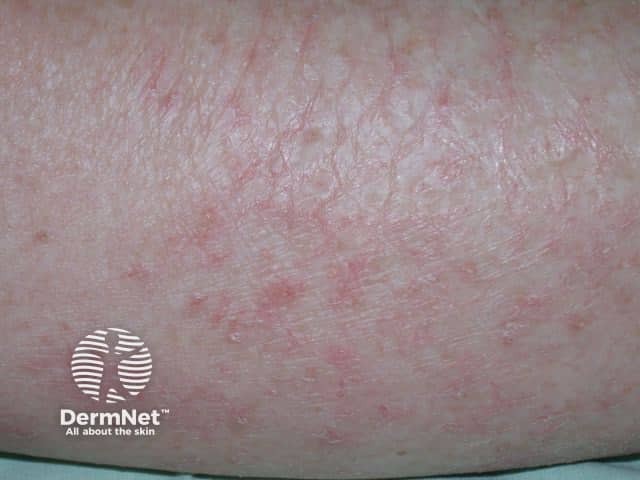
Dryness, redness, and scaling in postmenopausal asteatotic eczema
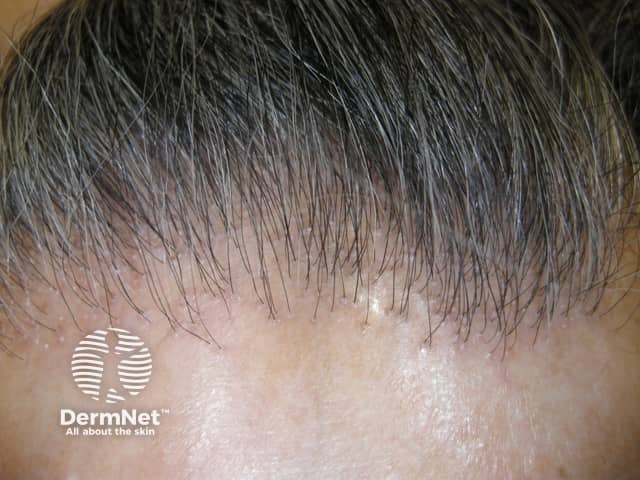
Frontal fibrosing alopecia - most commonly develops in perimenopause
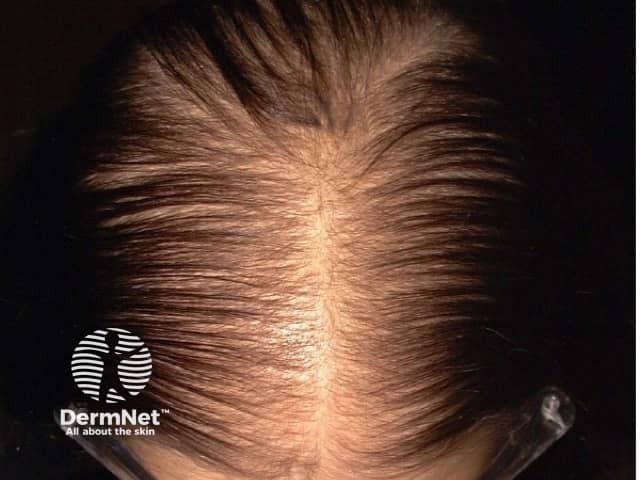
Diffuse hair thinning over the top of the scalp due to female pattern hair loss that accelerated after the menopause
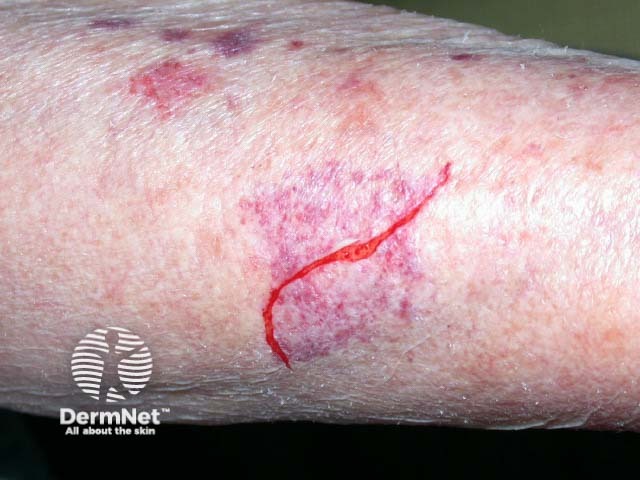
Skin fragility and bruising due to accelerated collagen loss is more common in postmenopausal women
Cutaneous features
Genital features
The term genitourinary syndrome, previously known as vulvovaginal atrophy, of menopause describes:
- Vaginal dryness, burning, irritation, and thinning of the skin (atrophic vulvovaginitis). The vulva is less affected (less oestrogen receptors)
- Sexual symptoms: lack of vaginal lubrication, discomfort, painful intercourse (dyspareunia), and loss of libido
- Urinary symptoms: urgency, dysuria, recurrent urinary tract infections.
Bacterial vaginosis
- Laboratory findings of BV are common after the menopause
- Many women are asymptomatic
- Malodorous vaginal discharge is common
Vaginitis
- There are several causes
- There may be a profuse discharge
Vulvovaginal candidiasis
- Less common in this age group than in younger women
- Fungal infection around the vaginal region
- Possibly associated with the use of HRT or oral contraceptives
Vulvar lichen sclerosus
- May be asymptomatic in some patients
- Possible association with autoimmune diseases
- Features include: itching, irritation, vaginal tears, dyspareunia, labial fusion and white, thinned, wrinkled skin.
Other skin conditions associated with menopause include:
Xerosis and itch
- Likely the most common complaint
- Oestrogens help maintain skin hydration, produce ceramides, sebum and hyaluronic acid
Asteatotic eczema
- The end result of increased skin dryness
Fine wrinkling
- Rapid loss of collagen in the first 5 years of the menopause
Easy bruising
- May be compounded by long-term sun damage
- Common on the arms and lower legs after even minor trauma
Hirsutism
- Facial hirsutism is very common in postmenopausal women not on HRT
Acne
- May be the result of an imbalance between oestrogens and testosterone
Rosacea
- May be exacerbated by menopausal flushing
Alopecia
- Approximately a third of post-menopausal women may develop hair loss
- This is usually at the front and on the top of the scalp
Frontal fibrosing alopecia
- Often arises in the peri and postmenopausal age group
Pigmentary changes
- Melasma is more common in the premenopausal years, but can be precipitated by hormone replacement therapy.
- Acquired bilateral melanosis of the neck is a condition seen in peri- and postmenopausal Asian women.
Keratoderma climactericum
- Thickening of skin on the palms and soles
- Occurs more commonly in obese postmenopausal women
- May be itchy, and painful cracking and splitting may occur
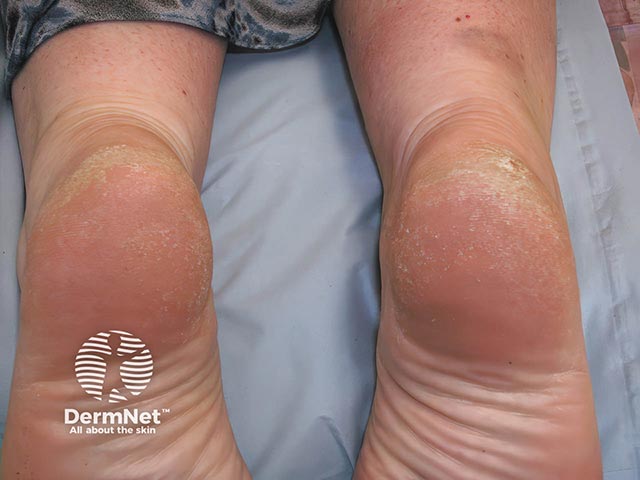
Thick dry skin which often fissures on the heels
What are the complications of menopause?
The various symptoms and signs of perimenopause and menopause can lead to significant psychosocial impact on self-esteem, relationships, day-to-day function and work.
Long term consequences of oestrogen deficiency of menopause also include:
- Increased risk of cardiovascular disease
- Bone mineral density loss leading to osteoporosis
- Overall cognitive decline.
How is menopause diagnosed?
The diagnosis of menopause or perimenopause in women over the age of 40 years is made based on menstrual cycle changes, with or without menopausal symptoms. Women aged between 40 and 45 years will require blood tests including serum hCG, prolactin, and TSH to exclude non-menopausal causes of changes to the menstrual cycle.
Women above the age of 45 years old do not require laboratory tests to make a diagnosis.
In women under the age of 40 years old, changes in the intermenstrual interval and the presence of menopausal symptoms is diagnosed as premature ovarian failure and this requires further investigation.
What is the differential diagnosis for menopause?
The differential diagnosis for irregular or absent menstrual periods include:
- Pregnancy
- Hyperthyroidism or hypothyroidism
- Hyperprolactinaemia
The skin changes seen in the menopause may accelerate normal chronological ageing.
Itch may be compounded by iron deficiency and hypothyroidism.
What is the treatment for menopause?
General measures
- Lifestyle changes such as exercise, weight loss, healthy eating, smoking cessation, good sleep hygiene.
- Moisturisers and emollient use, and soap avoidance for the skin dryness and itch
- Sun protection to reduce the compounding effect of light on collagen loss
Specific measures
Individualised treatment for dermatological peri- and postmenopausal symptoms include Menopause Hormone Therapy (MHT).
Topical oestrogen cream can help with vaginal symptoms and prevent recurrent urinary tract infections.
Systemic MHT or hormone replacement therapy (HRT) describes oestrogen therapy with or without progestin, and is the most effective treatment for vasomotor and genitourinary syndrome.
- MHT may offer improvement to adverse effects of menopause on the skin and hair.
- MHT is a safe option for symptomatic women who are under the age of 60 years or women who are within 10 years of menopause, without contraindications.
- Dosage forms of oestrogen include tablets, vaginal cream, injections or patches.
- Women with an intact uterus must take progestogen in addition to oestrogen to avoid endometrial hyperplasia and risk of endometrial cancer.
- Adverse risks associated with MHT include increased risk of breast cancer, venous thromboembolism, and stroke.
- MHT contraindications include: history of breast cancer, cardiovascular disease, previous venous thromboembolism or stroke, unexplained vaginal bleeding, high-risk endometrial cancer, transient ischemic attack or active liver disease.
Bibliography
- Stuenkel C, Davis S, Gompel A, et al. Treatment of symptoms of the menopause: an Endocrine Society clinical practice guideline. J Clin Endocrinol Metab. 2015; 100(11): 3975-4011. doi: 10.1210/jc.2015-2236. PubMed
- Woods N, Mitchell E. Symptoms during the perimenopause: prevalence, severity, trajectory, and significance in women’s lives. Am J Med. 2005; 19:118. doi:10.1016/j.amjmed.2005.09.031. PubMed
- Zouboulis C, Blume-Peytavi U, Kosmadaki M, et al. Skin, hair and beyond: the impact of menopause. Climacteric. 2022; 25 (5): 434-442. doi: 10.1080/13697137.2022.2050206. PubMed
- Kamp E, Ashraf M, Musbahi E, DeGiovanni C. Menopause, skin and common dermatoses. Part 1: hair disorders. Clin Exp Dermatol. 2022;47(12):2110–16. PubMed
- Kamp E, Ashraf M, Musbahi E, DeGiovanni C. Menopause, skin and common dermatoses. Part 2: skin disorders. Clin Exp Dermatol. 2022;47(12):2117–22. PubMed
On DermNet
- Atrophic vulvovaginitis
- Vaginitis
- Lichen sclerosus
- Flushing
- Excessive hair
- Hair loss, balding, hair shedding, alopecia
- Dry skin (xeroderma)
- Acquired keratoderma
Other websites
- Caring for your skin in menopause – American Academy of Dermatology Association
